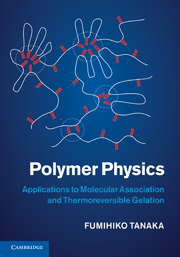Book contents
- Frontmatter
- Contents
- Preface
- 1 Statistical properties of polymer chains
- 2 Polymer solutions
- 3 Classical theory of gelation
- 4 Elasticity of polymer networks
- 5 Associating polymer solutions and thermoreversible gelation
- 6 Nongelling associating polymers
- 7 Thermoreversible gelation
- 8 Structure of polymer networks
- 9 Rheology of thermoreversible gels
- 10 Some important thermoreversible gels
- Index
- References
4 - Elasticity of polymer networks
Published online by Cambridge University Press: 16 May 2011
- Frontmatter
- Contents
- Preface
- 1 Statistical properties of polymer chains
- 2 Polymer solutions
- 3 Classical theory of gelation
- 4 Elasticity of polymer networks
- 5 Associating polymer solutions and thermoreversible gelation
- 6 Nongelling associating polymers
- 7 Thermoreversible gelation
- 8 Structure of polymer networks
- 9 Rheology of thermoreversible gels
- 10 Some important thermoreversible gels
- Index
- References
Summary
Rubbers and gels are three-dimensional networks composed of mutually cross-linked polymers. They behave like solids, but they still have high internal degrees of freedom that are free from constraints of external force; the random coils connecting the cross-links are free in thermal Brownian motion. The characteristic elasticity of polymeric materials appears from the conformational entropy of these random coils. In this chapter, we study the structures and mechanical properties of rubbers on the basis of the statistical-mechanical models of polymer networks.
Thermodynamics of rubber elasticity
Elastic properties of rubbers and gels are markedly different from those of metals, ceramics, and glasses. The properties of rubbers may be summarized as follows:
Their elastic moduli (Young modulus and rigidity) are very small (as small as 105–6 Nm–2, about 10–5 times as small as those of metals).
They have very high extensivity and restorability. They endure large deformation without rupture. They return to their initial dimensions even after being stretched to five to ten times their original size.
Their elastic moduli increases with temperature.
They are heated by adiabatic elongation, and cooled by adiabatic compression.
Thus, rubbers seem to be peculiar materials. We can, however, understand these unique properties very naturally if we consider that the main cause of the elasticity comes not from the interaction energy of the constituent molecules but from the conformational entropy of the chain segments, which are free to move.
- Type
- Chapter
- Information
- Polymer PhysicsApplications to Molecular Association and Thermoreversible Gelation, pp. 128 - 159Publisher: Cambridge University PressPrint publication year: 2011



